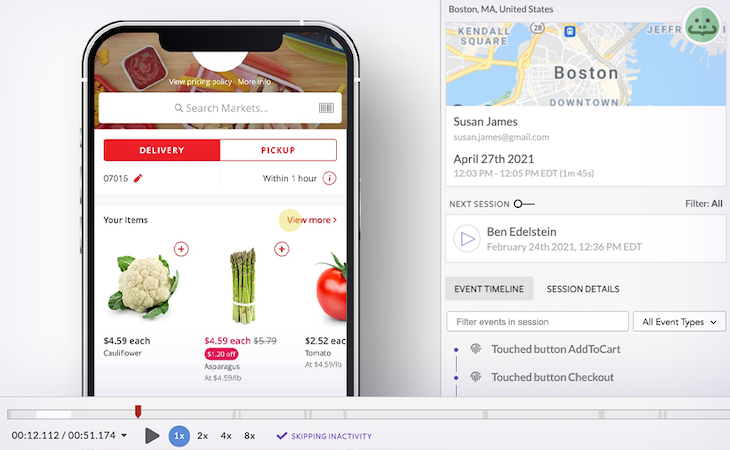There’s never been a better time to build native mobile apps. While the jury may have been out in the debate between mobile web and native mobile a few years ago, the verdict is now clear: consumers prefer native mobile apps because they deliver the best user experience.
With more than 5 million apps available across Apple’s App Store and Google Play, their convenience and accessibility has made them a constant presence in the lives of consumers, who now spend nearly 5 hours a day on mobile devices.
Meanwhile, tools like React Native and Flutter have exploded in popularity, making development faster and easier. This has sped up mobile development cycles, creating a more frequent release process that’s similar to web development.
What’s wrong?
The problem is that while mobile apps have taken off over the last few years — and the mobile developer experience has become increasingly similar to the web developer experience — the technology needed to monitor them hasn’t kept up with similar solutions for web.
A host of options are available for understanding frontend web apps, but developers lack tools for understanding and improving UX in native mobile apps. Being able to deploy faster and more frequently is great for agility, but it also means there’s more opportunity for errors to occur.
Additionally, despite there being multiple commonly used web browsers, one can build a web app once and be reasonably confident it will work in any browser. On mobile, even with recent advancements in cross-platform development frameworks, developers have to account for myriad device types, app and OS versions, and a wide range of connectivity options — including no connectivity at all. All of this combined means two otherwise identical device configurations can end up with completely different experiences.
Mobile is difficult
Traditional mobile monitoring solutions like Crashlytics, Instabug, and Sentry have focused on bug reporting and alerting. These tools provide some useful information, but they can get noisy and often don’t tell the entire story. Yes, there may be a bug, but does it have a meaningful impact on user experience?
Other tools allow users to provide additional context when self-reporting issues (such as screen recording), but most users never bother to report issues and just suffer in silence or churn. Once again, these options leave holes in your understanding. How many other users experienced this same problem? How many issues are going unreported?
LogRocket lets you answer key questions
When we started LogRocket six years ago, we set out to build the ultimate tool for frontend web debugging. When a user reports a problem, LogRocket shows you a video replay of exactly what they saw, alongside network and console logs, JavaScript errors, and application state to understand what went wrong.
Since then, we’ve used the data LogRocket collects to expand our capabilities to yield deeper insights into the user experience and allow for a proactive understanding of issues and their impact on users. In addition to helping you quickly solve user-reported issues, LogRocket also surfaces those things that go unreported — both technical and UX-related — and quantifies their impact, so you can prioritize and resolve the items that have the greatest effect on your business.
Now, LogRocket is bringing all that to native mobile apps. By combining high-fidelity, performant session replay with performance monitoring and app analytics, LogRocket allows you to understand the mobile user experience so you can deliver the best product to customers.

How it works
Session replay remains at the heart of everything we do. LogRocket captures changes to the mobile app structure at regular intervals, identifies the actions that draw to the screen, then replays those operations to create a smooth, highly accurate session replay.
LogRocket observes the hierarchical structure of native apps to capture swipes, touches, and other interactions. This approach also allows LogRocket to redact PII and other sensitive data to protect user privacy, and the time it takes for LogRocket to capture these changes is so small that the performance impact is negligible.
When users have poor network connections or are offline, LogRocket buffers data, sending it to the cloud once connectivity improves, providing visibility into the user experience even when users are off the grid.
LogRocket tracks errors, crashes, network requests and responses, performance data, and UX issues in every session. Each issue is displayed directly alongside the replay to show exactly what the user experienced at the moment the issue occurred. Deep integrations with libraries like React Native, Expo, and Redux, as well as with backend tools like Datadog and Splunk, allow for a quick and easy understanding of why any problem occurred.
Session replays offer insight into individual experiences, but most people don’t have the time (or the desire) to spend all day watching sessions to unearth user issues. That’s why LogRocket aggregates session replay data to surface issues that affect UX or key business metrics like conversion rates, allowing you to proactively identify and resolve issues.
LogRocket’s mission is to combat the noise typically seen in issue tracking and alerting solutions, helping customers focus on the problems that negatively affect users. Spend less time sifting through piles of issues and more time fixing the ones that are important.
Mobile frontend is the future
The convenience and accessibility of native mobile apps has been great for consumers, and improvements in dev tools have made it easier than ever to meet their demand. But as mobile development becomes more like web development, the solutions used to monitor, track, and analyze mobile apps must keep pace with those for the web in order to minimize bugs and ensure outstanding user experiences.
At LogRocket, we’ve taken a big step towards a solution, but there’s lots more work to do. If you want to help define the next generation of frontend tooling for mobile (and web) developers, we’d love to meet you. We’re hiring. 
The post Rethinking mobile app monitoring appeared first on LogRocket Blog.
from LogRocket Blog https://ift.tt/GonlOCX
via Read more



